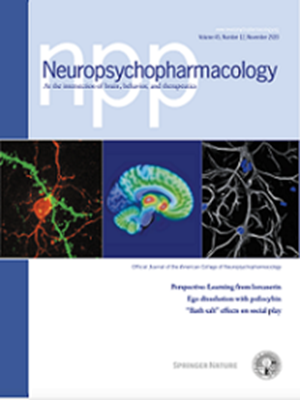Psilocybin therapy for mood dysfunction in Parkinson’s disease: an open-label pilot trial
IF 6.6
1区 医学
Q1 NEUROSCIENCES
引用次数: 0
Abstract
Mood dysfunction is highly prevalent in Parkinson’s disease (PD), a main predictor of functional decline, and difficult to treat—novel interventions are critically needed. Psilocybin shows early promise for treating depression and anxiety, but its potential in PD is unknown, as safety concerns have excluded people with neurodegenerative disease from previous trials. In this open-label pilot (NCT04932434), we examined the feasibility of psilocybin therapy among people with mild to moderate stage PD plus depression and/or anxiety. 12 participants (mean age 63.2 ± 8.2 years, 5 women) received psilocybin (one 10 mg followed by one 25 mg dose) with psychotherapy. There were no serious adverse events, no medical interventions required to manage effects of psilocybin, and no exacerbation of psychosis. Ten participants experienced treatment-emergent adverse events; the most frequent were anxiety, nausea, and increased blood pressure. We observed no worsening of PD symptomology measured by the Movement Disorder Society Unified Parkinson’s Disease Rating Scale (MDS-UPDRS). On the contrary, non-motor (MDS-UPDRS Part I: –13.8 ± 1.3, p < 0.001, Hedges’ g = 3.0) and motor symptoms (Part II: –7.5 ± 0.9, p < 0.001, g = 1.2; Part III: –4.6 ± 1.3, p = 0.001; g = 0.3) as well as performance in select cognitive domains (Paired Associates Learning [-0.44 ± 0.14, p = .003, g = 0.4], Spatial Working Memory [–0.52 ± 0.17, p = 0.003, g = 0.7], and Probabilistic Reversal Learning [2.9 ± 0.9, p = 0.003, g = 1.3]) improved post-treatment, and improvements were sustained until the final safety assessment one month following drug exposure. Baseline Montgomery-Asberg Depression Rating Scale (MADRS) and Hamilton Anxiety Rating Scale (HAM-A) scores were 21.0 ± 8.7 and 17.0 ± 3.7, respectively. Both improved to a clinically meaningful degree post-treatment; these improvements persisted to the final assessment three months following drug exposure (MADRS: -9.3 ± 2.7, p = .001, g = 1.0; HAM-A: –3.8 ± 1.7; p = 0.031, g = 0.7). This study provides the first data on psilocybin’s effects in any neurodegenerative disease. Results suggest that psilocybin therapy in PD warrants further investigation.

裸盖菇素治疗帕金森病心境障碍:一项开放标签试点试验。
情绪障碍在帕金森病(PD)中非常普遍,是功能衰退的主要预测因素,并且难以治疗-迫切需要新的干预措施。裸盖菇素显示出治疗抑郁和焦虑的早期希望,但其在PD中的潜力尚不清楚,因为安全性考虑已将患有神经退行性疾病的患者排除在先前的试验之外。在这个开放标签试验(NCT04932434)中,我们检查了裸盖头素治疗轻度至中度PD合并抑郁和/或焦虑患者的可行性。12名参与者(平均年龄63.2±8.2岁,5名女性)接受裸盖菇素治疗(一次10 mg,一次25 mg)。没有严重的不良事件,不需要医疗干预来控制裸盖菇素的效果,也没有精神病的恶化。10名参与者经历了治疗后出现的不良事件;最常见的症状是焦虑、恶心和血压升高。我们观察到通过运动障碍学会统一帕金森病评定量表(MDS-UPDRS)测量的PD症状没有恶化。相反,非电机(MDS-UPDRS第一部分:-13.8±1.3,p
本文章由计算机程序翻译,如有差异,请以英文原文为准。
求助全文
约1分钟内获得全文
求助全文
来源期刊

Neuropsychopharmacology
医学-精神病学
CiteScore
15.00
自引率
2.60%
发文量
240
审稿时长
2 months
期刊介绍:
Neuropsychopharmacology is a reputable international scientific journal that serves as the official publication of the American College of Neuropsychopharmacology (ACNP). The journal's primary focus is on research that enhances our knowledge of the brain and behavior, with a particular emphasis on the molecular, cellular, physiological, and psychological aspects of substances that affect the central nervous system (CNS). It also aims to identify new molecular targets for the development of future drugs.
The journal prioritizes original research reports, but it also welcomes mini-reviews and perspectives, which are often solicited by the editorial office. These types of articles provide valuable insights and syntheses of current research trends and future directions in the field of neuroscience and pharmacology.
 求助内容:
求助内容: 应助结果提醒方式:
应助结果提醒方式:


